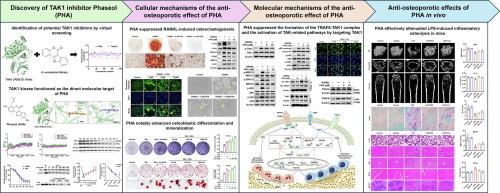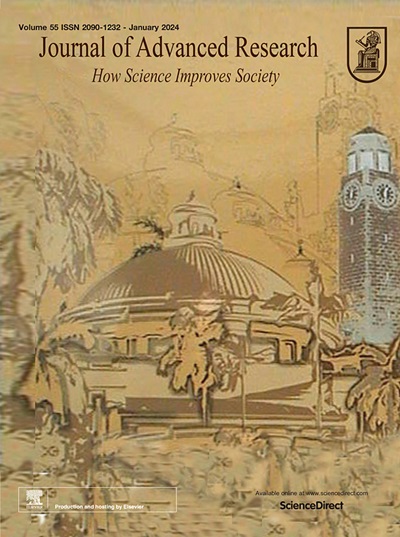通过靶向TAK1激酶对破骨细胞形成和成骨细胞分化的双重调控来治疗骨质疏松
IF 13
1区 综合性期刊
Q1 MULTIDISCIPLINARY SCIENCES
引用次数: 0
摘要
骨质疏松症是一种由成骨细胞介导的成骨和破骨细胞驱动的骨吸收之间的不平衡引起的溶骨性疾病。安全有效的骨质疏松症治疗方法仍然是迫切需要的。目的探讨相酚(phaseol, PHA)在体外和体内的骨保护作用及其机制。方法虚拟筛选从库米斯坦类药物中鉴定转化生长因子- β活化激酶1 (TAK1)的潜在抑制剂。通过分子模拟、酶解和耐热性实验研究了PHA与TAK1的相互作用。采用抗酒石酸酸性磷酸酶染色法、骨吸收法和f -肌动蛋白环形成法测定破骨细胞的成熟程度和功能。碱性磷酸酶染色和茜素红S染色观察成骨细胞的分化和钙化情况。利用免疫印迹法、免疫荧光法和共免疫沉淀法检测相关靶点和通路的活性。采用脂多糖(LPS)诱导的小鼠骨质疏松模型评估PHA的体内骨保护作用。结果首先,我们证实TAK1通过调节成骨和破骨细胞的发生,在骨重塑中起重要作用。此外,通过虚拟和真实实验,发现豆科植物中主要存在的原醛化合物PHA是一种有效的TAK1抑制剂。随后,PHA在体外被观察到促进成骨细胞分化和钙化,同时抑制破骨细胞成熟和骨吸收功能。机制上,PHA显著抑制TRAF6-TAK1复合物的形成,并通过靶向TAK1抑制TAK1、MAPK和NF-κB通路的激活。在体内研究中,PHA在脂多糖诱导的骨质疏松小鼠中强烈减弱骨质流失、炎症反应和破骨细胞过度活化。结论pha通过靶向TAK1,抑制TRAF6-TAK1复合物的生成,并调节其相关信号通路,对骨质形成和破骨细胞形成具有双重功能调控作用,最终达到缓解骨质疏松的目的。这项研究提供了令人信服的证据,支持使用PHA作为骨合成代谢和抗再吸收剂来预防和治疗骨质疏松症。本文章由计算机程序翻译,如有差异,请以英文原文为准。


Dual regulation of phaseol on osteoclast formation and osteoblast differentiation by targeting TAK1 kinase for osteoporosis treatment
Introduction
Osteoporosis is an osteolytic disorder resulting from an inequilibrium between osteoblast-mediated osteogenesis and osteoclast-driven bone absorption. Safe and effective approaches for osteoporosis management are still highly demanded.
Purpose
This study aimed to examine the osteoprotective effect and the mechanisms of phaseol (PHA) in vitro and in vivo.
Methods
Virtual screening identified the potential inhibitors of transforming growth factor-beta-activated kinase 1 (TAK1) from coumestans. The interaction between PHA and TAK1 was investigated by molecular simulation, pronase and thermal resistance assays. The maturation and function of osteoclasts were determined using tartrate-resistant acid phosphatase staining, bone absorption and F-actin ring formation assays. The differentiation and calcification of osteoblasts were assessed by alkaline phosphatase staining and Alizarin Red S staining. The activity of related targets and pathways were detected using immunoblotting, immunofluorescence and co-immunoprecipitation assays. The in vivo osteoprotective effect of PHA was evaluated using a lipopolysaccharide (LPS)-induced mouse osteoporosis model.
Results
Firstly, we confirmed that TAK1 was essential in controlling bone remodeling by regulating osteogenesis and osteoclastogenesis. Moreover, PHA, a coumestan compound predominantly present in leguminous plants, was identified as a potent TAK1 inhibitor through virtual and real experiments. Subsequently, PHA was observed to enhance osteoblast differentiation and calcification, while suppress osteoclast maturation and bone resorptive function in vitro. Mechanistically, PHA remarkably inhibited the TRAF6-TAK1 complex formation, and inhibited the activation of TAK1, MAPK and NF-κB pathways by targeting TAK1. In the in vivo study, PHA strongly attenuated bone loss, inflammatory responses, and osteoclast over-activation in lipopolysaccharide-induced osteoporosis mice.
Conclusion
PHA had a dual-functional regulatory impact on osteogenesis and osteoclastogenesis by targeting TAK1, suppressing TRAF6-TAK1 complex generation, and modulating its associated signaling pathways, ultimately leading to mitigating osteoporosis. This study offered compelling evidence in favor of using PHA for preventing and managing osteoporosis as both a bone anabolic and anti-resorptive agent.
求助全文
通过发布文献求助,成功后即可免费获取论文全文。
去求助
来源期刊

Journal of Advanced Research
Multidisciplinary-Multidisciplinary
CiteScore
21.60
自引率
0.90%
发文量
280
审稿时长
12 weeks
期刊介绍:
Journal of Advanced Research (J. Adv. Res.) is an applied/natural sciences, peer-reviewed journal that focuses on interdisciplinary research. The journal aims to contribute to applied research and knowledge worldwide through the publication of original and high-quality research articles in the fields of Medicine, Pharmaceutical Sciences, Dentistry, Physical Therapy, Veterinary Medicine, and Basic and Biological Sciences.
The following abstracting and indexing services cover the Journal of Advanced Research: PubMed/Medline, Essential Science Indicators, Web of Science, Scopus, PubMed Central, PubMed, Science Citation Index Expanded, Directory of Open Access Journals (DOAJ), and INSPEC.
 求助内容:
求助内容: 应助结果提醒方式:
应助结果提醒方式:


